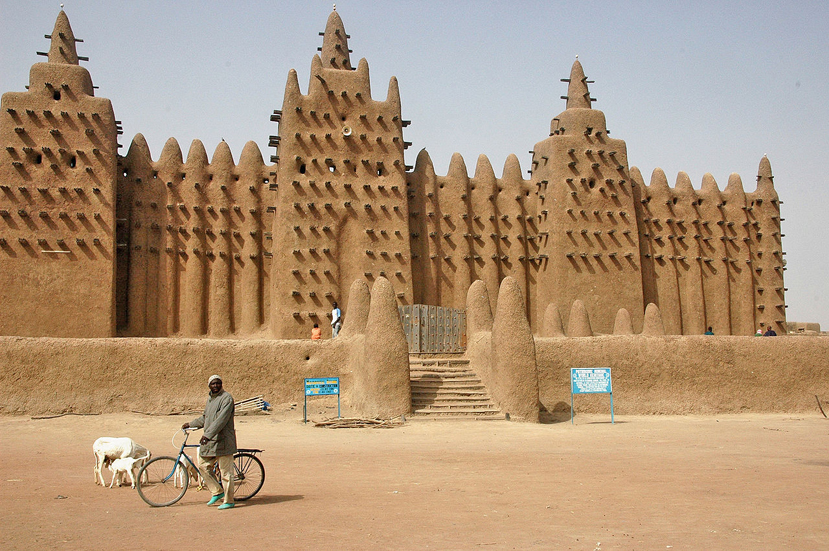The Great Mosque of Djenné is the largest sacred clay building and is considered a highlight of the Sudanese-Sahelian architecture in Mali.
The first mosque in Djenné was built between 1180 and 1330. The Imam of the Es-Sa’di mosque wrote in 1620 that in the year 1180 Sultan Koi Konboro converted to Islam. He later handed over the palace to him and had the first mosque in Djenné built for the believers. Later the tower and an additional wall were built, and today 1240 is considered the year of its foundation.
Amadu Hammadi Bubu, the founder of the Massina Empire, let the 600-year-old mosque collapse in 1834, which happened in a short time due to continued rain. He then he considered that mosque, emerged from a palace, too exuberant and luxurious. The only remaining part of the original building is the enclosure containing the tombs of local leaders. The second mosque was built again around 1896 on the basis of the old plans, this time more humble in appearance. It was demolished again to build the mosque that exists today, which was made similar in appearance and size to the first. The construction of the present Great Mosque began in 1906 and was completed between 1907 and 1909. Ismaila Traoré, the president of the masons guild directed and supervised its construction. At that time, Djenné was part of French West Africa and the French were able to offer economic and political support for the construction of the mosque and a nearby madrasa.
The Great Mosque of Djenné is one of the most famous buildings in Africa and was declared a World Heritage Site by UNESCO in 1988, together with the old town of Djenné and some of the surrounding archaeological sites.
Access : Coordinates: 13.905278, -4.555556 / The Great Mosque of Djenné constitutes the center of the city of Djenné, in Mali, in the alluvial plain of Bani, tributary of Niger. / The ancient city of Jenne is located 354 kilometers southwest of Timbuktu and 400 kilometers northeast of Bamako, the capital of Mali.
Highlights :
- The mosque is a typical example of the Sudanese-Sahelian architectural style in which rectangular buildings are constructed in such a way that they are well defensible. The mosque has many features of a fortress. The building has three square minarets. These are equipped with speakers that are used in the azan, the call to prayer. On top of each minaret are one or more ostrich eggs. The roof can be reached from the top floor of the minarets. In addition, the building also has two dungeons.
- The dimensions of the structure reach 75×75 meters, and the height of the minarets is 50 meters.
- This mosque is one of the most important symbols of both the city of Djenné and the state of Mali.
- In an annual festival, which usually takes place in April, the residents of Djenné work together to repair the damage that the rainy season has caused the mosque.
- Advice : The entrance to the Great Mosque of Djenné is open only to Muslims, as warned by information boards at the entrance to the religious building.
Go next : Old city of Djenné, It has been recognized as a World Heritage Site./ Bamako, the capital of Mali.

